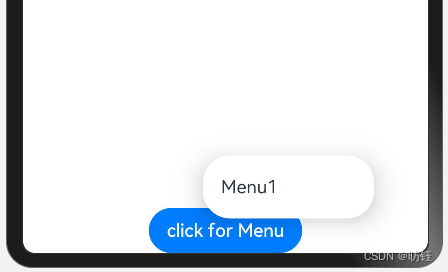jsp动态网站开发考试题阜平网站seo
目录
1、添加气泡
1.1、文本提示气泡
1.2、带按钮的提示气泡
1.3、自定义气泡
2、菜单
2.1、创建默认样式的菜单
2.2、创建自定义样式的菜单
1、添加气泡
Popup属性可绑定在组件上显示气泡弹窗提示,设置弹窗内容、交互逻辑和显示状态。主要用于屏幕录制、信息弹出提醒等显示状态。
气泡分为两种类型,一种是系统提供的气泡PopupOptions,一种是开发者可以自定义的气泡CustomPopupOptions。其中PopupOptions为系统提供的气泡,通过配置primaryButton、secondaryButton来设置带按钮的气泡。CustomPopupOptions通过配置builder参数来设置自定义的气泡。
1.1、文本提示气泡
文本提示气泡常用于只展示带有文本的信息提示,不带有任何交互的场景。Popup属性需绑定组件,当bindPopup属性中参数show为true的时候会弹出气泡提示。
在Button组件上绑定Popup属性,每次点击Button按钮,handlePopup会切换布尔值,当其为true时,触发bindPopup弹出气泡。
@Entry
@Component
struct TextPopupExamplePage {@State handlePopup: boolean = falsebuild() {Column() {Button('PopupOptions').onClick(() => {this.handlePopup = !this.handlePopup}).bindPopup(this.handlePopup, {message: 'This is a popup with PopupOptions',})}.width('100%').height('100%').padding({ top: 5 }).justifyContent(FlexAlign.Center)}
}效果如下:

在上面的例子中,气泡是显示在按钮的下面,那如下按钮下面没有空间了气泡会显示在哪里呢?
修改代码如下:
@Entry
@Component
struct TextPopupExamplePage {@State handlePopup: boolean = falsebuild() {Column() {Button('PopupOptions').onClick(() => {this.handlePopup = !this.handlePopup}).bindPopup(this.handlePopup, {message: 'This is a popup with PopupOptions',})}.width('100%').height('100%').padding({ top: 5 }).justifyContent(FlexAlign.End)}
}

气泡会调整到按钮的上面,也就是会根据可用空间调整显示位置。
1.2、带按钮的提示气泡
通过primaryButton、secondaryButton属性为气泡最多设置两个Button按钮,通过此按钮进行简单的交互;开发者可以通过配置action参数来设置想要触发的操作。
@Entry
@Component
struct PopupWithBtnPage {@State handlePopup: boolean = falsebuild() {Column() {Button('PopupOptions').margin({ top: 200 }).onClick(() => {this.handlePopup = !this.handlePopup}).bindPopup(this.handlePopup, {message: 'This is a popup with PopupOptions',primaryButton: {value: 'Confirm',action: () => {this.handlePopup = !this.handlePopupconsole.info('confirm Button click')}},secondaryButton: {value: 'Cancel',action: () => {this.handlePopup = !this.handlePopup}},})}.width('100%').padding({ top: 5 })}
}效果如下:

1.3、自定义气泡
开发者可以使用构建器CustomPopupOptions创建自定义气泡,@Builder中可以放自定义的内容。除此之外,还可以通过popupColor等参数控制气泡样式。
@Entry
@Component
struct CustomPopupPage {@State customPopup: boolean = false// popup构造器定义弹框内容@BuilderpopupBuilder() {Row({ space: 2 }) {Image($r("app.media.smile_beam")).width(24).height(24).margin({ left: 5 })Text('This is Custom Popup').fontSize(15)}.width(200).height(50).padding(5)}// popup构造器定义弹框内容@Builder popupBuilder2() {Row({ space: 2 }) {Image('/images/shengWhite.png').width(30).objectFit(ImageFit.Contain)Column(){Text('控制人生').fontSize(14).fontWeight(900).fontColor(Color.White).width('100%')Text('想要跟唱时,数千万歌曲任你选择,人声随心调整。').fontSize(12).fontColor('#ffeeeeee').width('100%')}}.width(230).height(80).padding(5)}build() {Column() {Button('CustomPopupOptions').position({ x: 100, y: 200 }).onClick(() => {this.customPopup = !this.customPopup}).bindPopup(this.customPopup, {builder: this.popupBuilder2, // 气泡的内容placement: Placement.Bottom, // 气泡的弹出位置popupColor: Color.Pink // 气泡的背景色})}.height('100%')}
}
2、菜单
Menu是菜单接口,一般用于鼠标右键弹窗、点击弹窗等。具体用法请参考Menu控制。
2.1、创建默认样式的菜单
菜单需要调用bindMenu接口来实现。bindMenu响应绑定组件的点击事件,绑定组件后手势点击对应组件后即可弹出。
@Entry
@Component
struct SimpleMenuPage {@State message: string = 'Hello World'build() {Row() {Column() {Button('click for Menu').bindMenu([{value: 'Menu1',action: () => {console.info('handle Menu1 select')}}])}.width('100%')}.height('100%').alignItems(VerticalAlign.Center)}
}效果如下:

如果按钮是在顶部或者底部,菜单则会自动调整显示位置,修改代码如下:
@Entry
@Component
struct SimpleMenuPage {@State message: string = 'Hello World'build() {Row() {Column() {Button('click for Menu').bindMenu([{value: 'Menu1',action: () => {console.info('handle Menu1 select')}}])}.width('100%')}.height('100%').alignItems(VerticalAlign.Bottom)}
}效果如下:

2.2、创建自定义样式的菜单
当默认样式不满足开发需求时,可使用@Builder自定义菜单内容。可通过bindMenu接口进行菜单的自定义。
@Entry
@Component
struct CustomMenuPage {@State select: boolean = trueprivate iconStr: ResourceStr = $r("app.media.ic_public_settings")private iconStr2: ResourceStr = $r("app.media.ic_public_settings")@BuilderSubMenu() {Menu() {MenuItem({ content: "复制", labelInfo: "Ctrl+C" })MenuItem({ content: "粘贴", labelInfo: "Ctrl+V" })}}@BuilderMyMenu() {Menu() {MenuItem({ startIcon: $r("app.media.icon"), content: "菜单选项" })MenuItem({ startIcon: $r("app.media.icon"), content: "菜单选项" }).enabled(false)MenuItem({startIcon: this.iconStr,content: "菜单选项",endIcon: $r("app.media.ic_public_arrow_right"),// 当builder参数进行配置时,表示与menuItem项绑定了子菜单。鼠标hover在该菜单项时,会显示子菜单。builder: this.SubMenu.bind(this),})MenuItemGroup({ header: '小标题' }) {MenuItem({ content: "菜单选项" }).selectIcon(true).selected(this.select).onChange((selected) => {console.info("menuItem select" + selected);this.iconStr2 = $r("app.media.icon");})MenuItem({startIcon: this.iconStr2,content: "菜单选项",endIcon: $r("app.media.ic_public_arrow_right"),builder: this.SubMenu.bind(this)})}MenuItem({startIcon: this.iconStr2,content: "菜单选项",endIcon: $r("app.media.ic_public_arrow_right")})}}build() {Row() {Column() {Button('click for Menu').bindMenu(this.MyMenu)Button('long click for menu').bindContextMenu(this.MyMenu, ResponseType.LongPress).margin({ top: 24 })}.width('100%')}.height('100%')}
}效果如下:

- 通过bindMenu绑定菜单。
- 通过bindContextMenu接口进行菜单的自定义及菜单弹出的触发方式:右键或长按。使用bindContextMenu弹出的菜单项是在独立子窗口内的,可显示在应用窗口外部。
